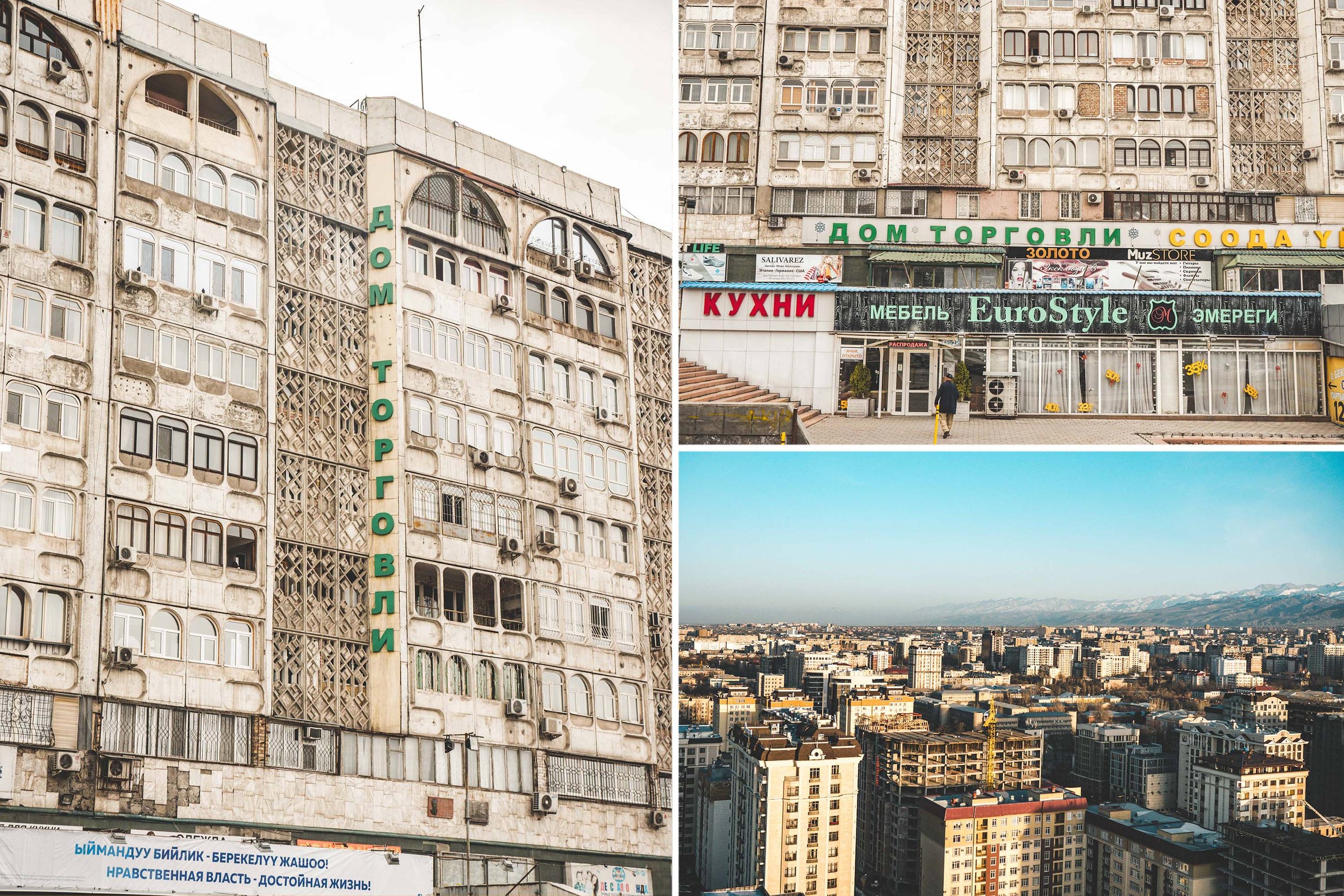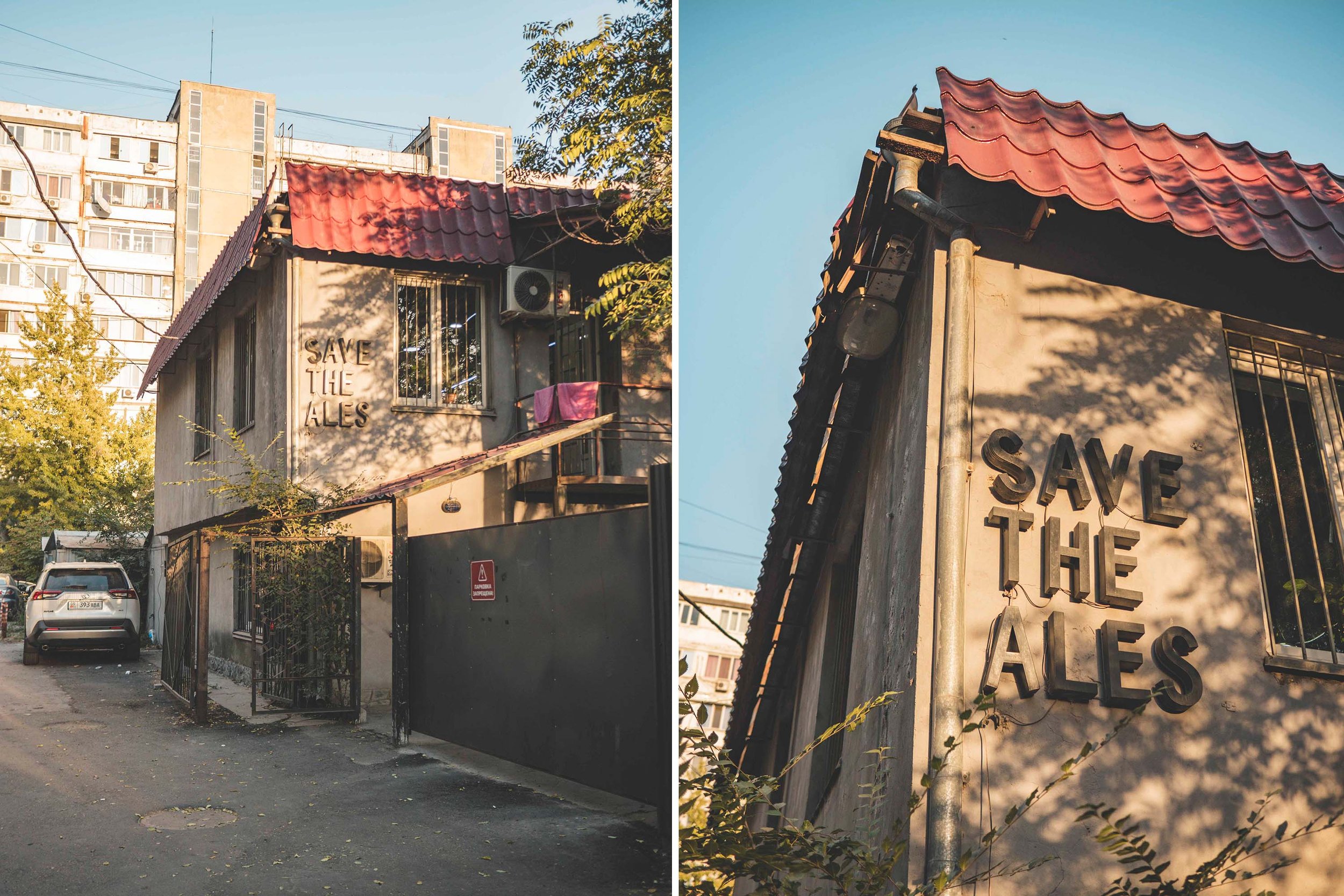An unobtrusive sign with Roman letters hangs in front of Mabuhay, a craft beer tasting room. Inside, the menu above the bar is in English. The bartender, Sergey, greets us in Russian, but his words are drowned out by the rolling Ns and sharp Ks of the group behind him, who are speaking loudly in Kyrgyz. As was true of the Silk Road caravanserais—roadside inns—of bygone days, such a mix of cultures and languages is emblematic of Bishkek, the capital of Kyrgyzstan.
Located in the middle of Central Asia, Kyrgyzstan lies south of Kazakhstan, between Uzbekistan and China, and north of Tajikistan. The mountainous country has a population of a little over 6 million people, mostly Kyrgyz, as well as Russian, Uzbek, Dungan, and Uyghur ethnic minorities.
Had it been left up to the previously nomadic, native Kyrgyz people, what was once called “Pishpek” may never have existed. The Kokand Khanate ruled the area and large swaths of modern Uzbekistan from 1709-1876, and it established a 19th-century fortress at a trading outpost here, forcing the roaming Kyrgyz tribes to pay tribute. Renamed “Frunze” by the Russian invaders in 1926, a city sprang up around the former fortress, becoming the administrative center of the region. After the fall of the Soviet Union, Bishkek recuperated a version of its original name.
Today the city is an urban bubble, home to some 900,000 people in a land of open steppe and sky. There is a significant NGO and aid sector present in the country; until a few years ago, there was also a large American military base in the south. Those influences have further contributed to Bishkek’s multifaceted identity, and many tastes and trends have entered the country through the desires of those expats.
In some ways, the market for craft beer is one of them. The first bars in the city to carry craft beers included expat institutions like Pinta Pub, a once-humble biergarten in the north of the city that has grown into a small chain pouring a range of international beers. But it is not alone: These days, products from local breweries can be found in many bars and restaurants, and even in specialty supermarkets. In 2022, Bishkek’s beer scene is as multifarious and fluid as the rest of the city.
I shake Sergey’s hand as I sit down at Mabuhay’s bar. He’s nervous to speak in English, especially as today I’m writing down what he says, but his naturally friendly demeanor can’t be held back by shyness for too long.
Mabuhay serves beer exclusively from Tengri Beer, which is located outside the city, and uses a former collective farm’s livestock barns to house its operations. Eleven of its beers are on tap tonight—normally all 12 taps are pouring, but the bar is out of Tengri’s sea-buckthorn-flavored cider. While the hops, malt, and yeast for Tengri’s beers are purchased abroad, the owners recently began keeping two apple orchards in the country’s eastern Issyk-Kul region to make their cider. That’s not a big departure—after all, apples were first domesticated in this part of Central Asia between 3,000 and 4,000 years ago, before spreading westwards along the Silk Road.
Sea buckthorn is commonly consumed in Kyrgyzstan, and the cider seems to go as fast as they can produce it. When I arrived in Bishkek, I was unfamiliar with the fruit. (Once, hoping to be helpful, my friend Mars, Kyrgyz from a Uyghur family, tried to jog my memory: “You must know what it is,” he said, checking his phone. “Here it is. In French, it is ‘Ananas de Siberie.’” My suspicions were confirmed: I definitely had never heard of “Siberian pineapple.”)
Usually I like to order the most outlandish beer on a given bar’s menu, but tonight I decide I should see how Bishkek does the classics. It’s been nearly six months since I first arrived in Kyrgyzstan, and after a month in Bishkek—and then four months on a cross-country horse trek in the mountains—I’ve come back to the capital to tie up my adventures. Following a summer drinking vodka on the steppe, it feels right to return to the fundamentals.
Sergey thinks I’ll like the APA best, so I order one, and my friends order an IPA and a cider. While he’s pulling the pints, laughter ripples out from the bar’s one large table. Half a dozen workplace colleagues are playing a card game. On their table, some patrons have beers, others bottles of Coke, and some are drinking tea from the same sleek glass teapots found in the chic cafés that decorate the center of Bishkek.
A lull hovers over Bishkek between working hours and going out, as residents run home for a bite to eat, a walk in the park, or to get ready for a night out. After our beers—and still relatively early in the evening—we head to a bar with a simple, circular logo at the entryway, and no name. Soon after we arrive, it begins to fill up with students, most of whom are dressed in black. The menu here is in Cyrillic, and our Russian is bad; we sound out the drinks in preparation to order.
While 2021 marked 30 years since Kyrgyzstan became an independent state, evidence of the country’s Soviet past is everywhere, a hovering, sometimes uneasy reminder. Russian and Kyrgyz are both official languages here, and in metropolitan Bishkek, it is trendy to speak Russian instead of Kyrgyz. In the provinces, the younger generation did not receive Soviet schooling and so speaks Kyrgyz predominantly, while the older generation speaks both. Students who study abroad frequently go to Russia, as do migrant workers, and more than a few ethnically Kyrgyz friends from Bishkek speak only Russian fluently, not Kyrgyz. This is despite the fact that the number of ethnic Russians in the country has steadily dwindled since the dissolution of the Soviet Union, and in 2021 was estimated to be fewer than 350,000, mostly in the capital and the north of the country.
During my summer travels across the country, I asked people how things have changed since the country’s independence. Those from older generations talked about how wonderful it is to live in a free Kyrgyzstan, but also shared nostalgia-tinged reminiscences about how education was better before, how everyone was assured a job, how health care was free, and how retirement pensions were guaranteed. From the younger generation, the outlook about the country’s future was more optimistic, in both the provinces and the cities, especially with regards to learning English, traveling abroad, or making a living in tourism.
The fall of the Soviet Union also brought a resurgence of religion. Kyrgyzstan is a predominately Muslim country. Once, in the village of Arslanbob, population 13,000, I made the mistake of trying to find a bottle of vodka during Ramadan. My friend Faysi shook his head and laughed. “Ashley, don’t you know it is Ramadan, you will not find it in the shops. Even if someone had some vodka, he could not give it to you because his neighbors might know. And then, where would you drink it? You cannot drink it in your host’s house; this would be disrespectful. Better to wait until after Ramadan, or go to the city to buy some.” Like in many countries, the cities are less conservative than the countryside, and so Bishkek attracts students, minorities, and anyone who does not fit the mold.
No Name Bar is a manifestation of this, and a testament to the elements of American culture that have filtered into the capital, which add another curious dimension to its mingled identity. Inside, the walls are decorated with memes and TV references. “Family Guy” plays on the television and Roger from “American Dad” is drawn on the whiteboard wall. But instead of feeling cringy, it feels cool. Pop music from the ’60s and ’70s plays as the bartenders measure out drinks and shake cocktails.
In keeping with the theme, our waitress is wearing a “Stranger Things” T-shirt and a pair of Crocs. There are no local beers on tap, but there is a Kazakh Lager, Karachaevskoe, which we order. It isn’t the other patrons’ beer of choice: The bartender points out that most people are drinking from shiny green bottles of Heineken, or from larger and less expensive bottles of Arpa, Kyrgyzstan’s answer to Budweiser. In the refrigerator are craft beers from Russia. The bartender suggests an IPA from St. Petersburg, but I turn it down. I need to keep my wits about me for our next stop.
Entering Somewhere Bistro on trivia night is an easy way to forget that you’re in Kyrgyzstan. Expats and exchange students fill the bar, and phrases in English, French, and Russian fly around the space. A drumset at the center of the back wall stands empty tonight, but Bishkek’s local acts periodically take the stage.
Opened in 2018, burned down in 2020, and reopened shortly thereafter, Somewhere Bistro is owned by Aurélie Marchiori and Sandeep Bijawat. The couple met in Bishkek during their studies, and when it came time to decide where to settle and open a bar, the city seemed like a good geographic compromise between their respective homelands of France and India.
“Our clients mostly drink beer,” Marchiori tells me. “But also a lot of vodka, and plenty of cocktails.” She has a point about the cocktails; though I was expecting vodka and beer to be the most popular options when I moved here, I was surprised to find a large selection of cocktails in Bishkek’s hippest bars. “On tap right now we have beer from Pivovarochka and Byomer breweries. They’re both local, and Pivovarochka is really good at the right price. Craft beer is expensive, and people in Kyrgyzstan are used to beer being ultra-cheap.”
“All those bars with cocktails didn’t exist. This bar existed, but it used to be a dirt road outside. And none of those buildings were here. The street was totally empty, not even a streetlight.”
When she says ultra-cheap, she means in relation to local buying power—the average salary in Bishkek is less than $200 per month. The most expensive craft beer I’ve found in Kyrgyzstan is around 350 Kyrgyz som—less than $4, with the average craft beer hovering around 200 som. A beer like Arpa costs less than a dollar.
“People like the IPA, but most just go for the Lager. It’s a taste they know,” Marchiori says, while the bartender pulls a pint for a Finnish expat working for the UN. “Most of the locals—Kyrgyz, Russian, or other—who order an APA or IPA here are those who have worked or studied abroad. Many of them go to Russia or further west, and so they’re familiar with different beers and like the hoppy flavors.”
Sipping my IPA, I deliberate on team names with my friends before the trivia quiz starts. We’ve just settled on “Bishkek Babes” when a few plates of checil land on our table. The four of us immediately descend on the stringy, smoked cheese that is one of the most popular bar snacks in Central Asia. It is overwhelmingly salty, chewy, and altogether addictive. The next time I see Marchiori, I grab her to ask the question that’s been eating up my stomach for months: How do bars get the checil so stringy? Whenever I’ve bought it in the stores, it’s braided and it never separates into the almost hairy little fibers of cheese we eat at the bar. Marchiori laughs sympathetically and tells me she wondered the same thing when she arrived. Then she reveals the secrets: It’s part of the kitchen food prep, and it takes hours!
The quiz begins. This week’s themes are Bishkek’s history, trees, and movie monsters. We try our best, and land in the final rankings exactly where we want: second place. The winners groan. No one wants to win trivia here: Although they get a free round of drinks, the winning team must prepare next week’s questions and host the contest.
The night isn’t over yet, so we decide to head for 111.
The cornerstone of Soviet urban planning consisted of micro districts, compact territories with all the services residents needed inside their boundaries, built as the cities sprawled ever larger. Bishkek’s original urban structure was typical Soviet-bloc-style buildings, but today Turkish contractors have won many of the new construction contracts, and the skyscrapers seem to sprout out of the ground. In the four months that I was away in the mountains, the skeletons of a half-dozen new buildings appeared downtown.
Suspended over a dry canal in the 10th micro district, 111 Bar feels like a university rock ‘n’ roll bar. A billiards table occupies the space in front of the small stage, and patrons wait their turn to play, drinking in booths on both sides of the bar. Pints of mass-market Lager sit on our table, probably Nash but I’m not sure. Each of us also has a glass containing a shallow pour of Kyrgyzstan-brand cognac. Plates of roasted and salted fava beans cover the table. Maxime, a freelance photographer who settled in Bishkek, remembers finding this bar five years ago, and tells us how the city has changed since his arrival.
“All those bars with cocktails didn’t exist,” he says. “This bar existed, but it used to be a dirt road outside. And none of those buildings were here. The street was totally empty, not even a streetlight. The inside hasn’t changed though.” He raises his glass, and we toast with our cognacs, taking small sips since the first taste is pretty spicy, and eating a few salty, crunchy fava beans after to cut the bite.
The group playing a round of pool makes a sign, and it’s our turn. When we finally laugh our way out the door at 3 a.m., our clothes reek of cigarette smoke. Smoking inside is forbidden but not enforced in Bishkek. Loading up in the local answer to Uber, called Yandex, we cross the city three times, searching for any dance club that’s still open. We fail. Bishkek may have grown a lot in the past five years, but it isn’t a city of endless nightlife. The afterparty ends before it can begin, and our taxi slowly empties out until it’s only me and my boyfriend in the car. Our friends stiff us on the bill, which comes to a whopping 350 som.
The next day, we start early: At 7 p.m., bars and restaurants are still opening up for the evening, Brewster among them.
It was Edil Tilekov who introduced me to the bar. Tilekov is one of Brewster’s former owners, and a self-professed beer geek. He told me about his discovery of craft beer while abroad, which changed his opinion about the mass-market, inexpensive beer back in Kyrgyzstan. When he returned home, he began teaching himself to brew his own beer. His skill improved with each new batch, and by 2017 he was ready to open Brewster. At the time, the bar initially attracted mostly expats and other beer fans.
“One time a guy from Miami who was visiting Almaty [in neighboring Kazakhstan] saw one of our beers on the Untappd application,” he says. “He made the four-hour drive to come taste it.”
Brewster is below street-level, with small windows at the top of the wall opening onto the sidewalk. In the refrigerator sits a large selection of craft beers. Most of them come from breweries in Russia, like Jaws Brewery, from Beloyarsky in Western Siberia, or AF Brew from St. Petersburg. On tap are eight beers, the majority from Raccoon Brewing Co. The brewery itself is just outside Bishkek, in an old collective stables, a relic from the USSR.
“One time a guy from Miami who was visiting Almaty [in neighboring Kazakhstan] saw one of our beers on the Untappd application. He made the four-hour drive to come taste it.”
As I browse the menu, I notice the playful names, like What the Fog? and Sweet Tears and Salty Kisses, as well as the wide range of styles. Kostya, the bartender, carefully explains each beer to us. “Why don’t you just taste them all?” he asks, and starts lining up sampling glasses. Amid the Sours, fruity meads and classics, I choose a Milkshake IPA with the light flavor of oolong tea. My friends order a New England IPA, a strawberry Gose, and a Double IPA.
In between tastes, I ask Kostya why Sours outnumber the other beer styles. “In Kyrgyzstan we’re good at fermenting things,” he says. “Our Sours are made using local traditions.”
He’s right: The national drink is fermented mare’s milk, known as kumis. I briefly imagine a brewer churning the beer the way a shepherd’s wife living in a yurt would churn the kumis. “We have a lot of berries growing in the mountains, which we use in the beers,” Kostya continues. “Plus people seem to like them, so we keep brewing them.”
As we’re drinking, a few regulars roll in, but the bar stays relatively calm. Though they’re technically competitors, a Mabuhay coaster is taped to the wall, alongside dozens of other stickers. I take advantage of Kostya’s availability to learn more about the craft beer scene. “We wanted to create and to be a part of a craft beer community,” he says, including starting a craft beer running club chapter. “We also have a bottle share club, where people bring different craft beers, and we exchange and taste the different beers.”
There was a recent craft beer festival outside Bishkek, he says, the first of its kind. “It was great, except the organizers let a big brand have a stand. All the craft breweries could agree on that: That guy shouldn’t have been there.” His enthusiasm is contagious, and I find myself rooting for the local Kyrgzy brewers, and hoping they’ll be able to find a secure place within the city’s quickly blossoming nightlife sector.
Our next stop is only a few streets away, but the story begins three hours’ drive north of Bishkek, across wide plains and a small mountain range, in the city of Almaty, Kazakhstan. Though she hails from Bishkek, Aida Musulmankulova lived in Almaty when she began brewing beer. The city is often a few years ahead of Bishkek when it comes to modern trends, but Musulmankulova changed that when she opened Save the Ales not in Almaty, but in Bishkek in 2016, becoming the first craft brewery in Kyrgyzstan and one of the first in Central Asia.
“In the beginning it was just family and friends who bought our beer. They wanted to support us,” she says. The expat crowd turned up next, and finally the locals came around. “People in Kyrgyzstan are used to beer with no taste. And they’re surprised that it’s brewed by a woman. When we opened people didn’t believe I was the owner.”
“People in Kyrgyzstan are used to beer with no taste. And they’re surprised that it’s brewed by a woman. When we opened people didn’t believe I was the owner.”
Musulmankulova has an undeniably forward-thinking spirit. Like other brewers in Bishkek, she began brewing beer at home with basic equipment. She gained knowledge and experience through trial and error, learning from YouTube videos and inspired by the beers that “actually had flavor,” as she puts it, that she’d sampled while a student abroad. The pastime became a passion. It took three years of saving and planning to bring Save the Ales to life.
As is true around the world, women in Kyrgyzstan often face an uphill battle to be credited for their work and respected within the craft beer industry. That factor made the early days of Save the Ales challenging.
“People thought the guy who owns the restaurant next door was the real owner. They’d ask him if I was lying,” Musulmankulova says. (The restaurant next door is Baan Baan Thai, a popular Thai restaurant where diners can order beers from neighboring Save the Ales or try homemade Thai sweet wine.) Luckily, those attitudes haven’t slowed Musulmankulova down.
Above the taproom, a waitress with dreads descends from the kitchen carrying a tray destined for a pair of blonde Russians seated at the table nearby. The kitchen at Save the Ales opened four years ago, and since then Musulmankulova has had a hand in each season’s menu. Alongside international favorites like burgers and fries, diners can find Central Asian cuisine on the menu: sautéed noodles, chopped salads, and horse meat sausage. The sausage, called chuchuk, can be loosely compared to Scottish haggis, and is ordered when you want to really impress someone.
The waitress arrives at our table with two flights of beer, while the Arctic Monkey’s album “AM” spills out from the speakers and golden-hour light floats over the beer garden. Alongside the Pale Ale, White and Red beers are a pair of ciders, one unflavored and the other sticky sweet with passion fruit. The ciders are made with apples grown near Issyk-Kul Lake, the largest lake in Kyrgyzstan and the second-largest saline lake in the world. That might sound like a home run for local taste preferences, but Musulmankulova has her own favorites.
“Our ciders, both dry and sweet, are really popular,” she says. “But I prefer the IPA.” When I wonder aloud what’s next for the brewery, Musulmankulova says that she likes to experiment. “I bought some smoked wheat on a whim and will try that next.” While she sips her glass, I also enjoy an IPA, but a version brewed with that very special local ingredient: Sea buckthorn makes an appearance again.
While drinking with Musulmankulova, I ask if she feels cramped in Bishkek, which despite being the largest city in Kyrgyzstan can sometimes feel like a small town. What she wishes, she says, is for Kyrgyzstan and Bishkek to have their own suppliers. And there is room for it: The country has large swaths of fertile plains and grows barley as one of the primary grains for livestock. Neighboring Kazakhstan was one of the wheat breadbaskets of the Soviet Union. Despite those resources, Musulmankulova has to import almost all the brewery’s primary ingredients, except water. Even that was originally imported, she says.
“In the beginning we brought in big bottles of spring water from the mountains,” she says. “Now we have a truck who delivers it, but we still don’t have the rest of the ingredients locally. Instead of having to order our malt from Germany, our yeast from France and our hops from the U.S., I wish we had someone making that here.”
Aside from being women-owned and -operated, Save the Ales is a special space for other reasons, Musulmankulova tells me. “There are not many LGBTQ+ friendly spaces in Bishkek. The society is still not ready for it. But we hosted an International Day of Visibility here at the brewery this year.”
Compared to neighboring countries like Uzbekistan, where homosexuality is illegal, Kyrgyzstan might seem more tolerant. But being openly LGBTQ+ in Kyrgyzstan still comes with myriad legal and cultural challenges. Inside the walls of Save the Ales, there is a feeling of intentional welcome, and Mulsulmankulova frames her space as a place where queer women can find safe employment.
Progress is still hard-won, but Bishkek is continuing to bring metropolitan growth to the middle of the old Silk Road. A shifting range of cultures and traditions—whose histories are measured in terms of civilizations, rather than years or decades—mark the city and its people today. Embracing the changing tastes of the society, and leaving their own imprint on the capital, Bishkek’s brewers, entrepreneurs, bartenders, and drinkers are a special part of the city in its current form. As Mulsulmankulova says, despite facing controversy and challenges, the important thing is that they’ve “built something we can be proud of.” And they’ve done it without heeding the words of those who didn’t believe in them.




















































